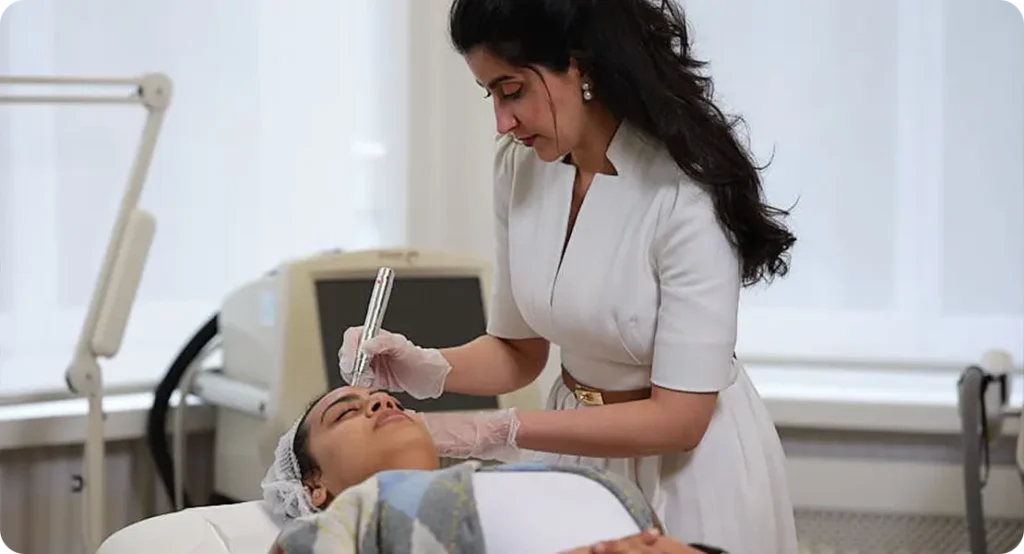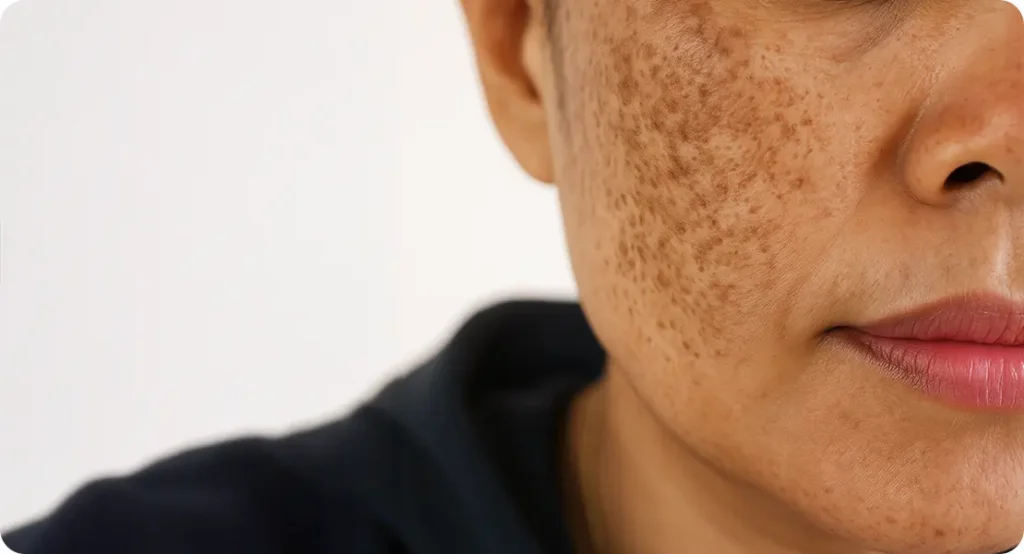Dark spots, uneven patches, and stubborn pigmentation can be more than just a cosmetic nuisance—they often affect how we feel about ourselves. Whether it’s melasma brought on by hormonal changes, sun spots accumulated over years of UV exposure, or post-inflammatory pigmentation following acne or injury, these issues are incredibly common and can be difficult to treat with skincare alone.
That’s where laser therapy comes in. At our clinic, we specialise in using advanced, targeted laser treatments to address pigmentation safely and effectively. With tailored approaches for each condition and skin type, our goal is to restore not only your skin’s clarity but also your confidence. In this article, we’ll explore how laser technology works, why it’s a game-changer for pigmentation, and how we use it to treat melasma, sun spots, and PIH with precision and care.
Whether you’re just starting to explore your options or have tried everything else, this guide will help you understand what’s possible—and how to get there safely.
Understanding Pigmentation and Its Causes
Pigmentation refers to the colouring of the skin, which is governed by melanin – a natural pigment produced by melanocytes. However, when melanin production becomes uneven, it can lead to localised dark patches or spots, known as hyperpigmentation. This can be triggered by sun exposure, hormonal changes, inflammation, and skin trauma.
Common conditions include melasma (often hormonally driven), sun spots (caused by prolonged UV exposure), and post-inflammatory hyperpigmentation (PIH) which can follow acne or injury. While pigmentation isn’t usually harmful, it can affect confidence and self-esteem. Many people try topical treatments with limited success.
Fortunately, modern laser technology now offers a more precise and effective solution for safely fading dark spots and achieving a clearer, more even skin tone. Clinics today use targeted laser treatments that are tailored to the pigmentation type and skin tone, reducing risk while maximising results.
Why Lasers Are Effective for Treating Pigmentation
Laser technology works by delivering concentrated beams of light into the skin to break down excess melanin without harming surrounding tissue. Different wavelengths target pigment at varying depths, which makes lasers highly effective for stubborn pigmentation that topical products cannot reach.
Compared to chemical peels or abrasive treatments, lasers are more controlled and precise, offering less risk of scarring or post-treatment discolouration. They’re particularly beneficial for conditions like melasma and PIH, where sensitivity is high and pigment lies deeper in the skin.
Advances in laser technology now allow clinicians to treat darker skin tones safely, by adjusting energy settings and pulse duration. This approach not only fades unwanted spots but stimulates skin renewal, enhancing overall texture and radiance. The choice of laser depends on the type of pigmentation and individual skin characteristics, which is why a personalised consultation is critical before starting treatment.
Targeting Melasma with Gentle Laser Protocols
Melasma is a notoriously stubborn form of pigmentation, often triggered by hormones, heat, and sun exposure. It commonly appears as symmetrical patches across the cheeks, forehead, and upper lip.
Treating melasma with lasers requires a gentle, layered approach to avoid triggering inflammation or rebound pigmentation. At our clinic, we use low-energy lasers like the Q-switched Nd:YAG or fractional picosecond lasers, which disperse pigment gradually without overheating the skin. These lasers emit ultrashort pulses that fragment melanin clusters while preserving surrounding tissue.
Treatments are spaced out over several sessions to allow the skin to calm and recover between each one. We also combine laser therapy with medical-grade skincare – such as antioxidants and pigment inhibitors – to prevent re-pigmentation. While complete eradication of melasma is rare, significant fading and improvement in skin tone uniformity can be achieved with patience and precision. Post-treatment sun protection is essential to maintain results and prevent recurrence.
Sun Spots: A Common Concern Treated with Precision
Sun spots, also known as solar lentigines, are caused by cumulative sun exposure over time. They often appear as flat, brown patches on sun-exposed areas such as the face, hands, and chest. These spots are typically superficial, making them well-suited for laser treatment.

At our clinic, we commonly use IPL (Intense Pulsed Light) or pigment-specific lasers like the Alexandrite or Nd:YAG to selectively target these darkened areas. The light energy is absorbed by the melanin in the spots, causing them to darken initially before flaking off naturally over the following days. Most patients see visible improvement after just one to three sessions, depending on the extent of pigmentation.
The procedure is quick, with minimal downtime and a low risk of side effects when performed by trained professionals. Sun protection and antioxidant-rich skincare are recommended post-treatment to maintain clarity and protect against further UV damage.
Treating Post-Inflammatory Hyperpigmentation (PIH)
PIH occurs when the skin over-produces melanin in response to inflammation, injury, or irritation – commonly after acne, eczema, or procedures like waxing or laser hair removal. Unlike melasma, PIH is not hormone-related and can occur at any age. It often affects those with medium to darker skin tones more severely. Lasers can be highly effective in treating PIH when used carefully.
At our clinic, we use low-fluence Q-switched lasers to gently break down pigment without aggravating the skin. This approach allows for gradual fading with minimal risk of further pigmentation or scarring. We often recommend combining laser treatments with ingredients like niacinamide, azelaic acid, or tranexamic acid to suppress melanin production and support skin recovery. Multiple sessions may be needed depending on the depth and duration of the pigmentation, but most patients see meaningful results within a few months. A consistent skincare routine and sun avoidance are key to maintaining progress.
Safe Treatment for All Skin Tones
Historically, laser treatments were considered risky for darker skin tones due to the increased risk of burns or post-treatment pigmentation. However, with modern technology and a better understanding of skin biology, this is no longer the case. At our clinic, we tailor treatment settings and laser types based on each patient’s Fitzpatrick skin type. We favour lasers with longer wavelengths (like 1064 nm Nd:YAG) for deeper penetration and reduced melanin absorption in the upper layers, which makes them safer for darker complexions. We also space treatments more widely and prioritise pre-treatment skin conditioning to strengthen the skin barrier. Safety is our top priority, and every treatment plan is developed with careful consideration of skin type, pigmentation type, and medical history. With the right technique, lasers can effectively and safely reduce pigmentation in all skin types, giving everyone access to clearer, more even-toned skin.
The Consultation Process: Customising Your Treatment Plan
Before beginning any laser treatment, we conduct a thorough consultation to assess the nature of your pigmentation and your skin’s tolerance. This includes a detailed medical history, digital skin analysis, and a discussion of your goals and lifestyle.
We identify whether the pigmentation is epidermal (surface-level) or dermal (deeper), which determines the choice of laser and treatment depth. Patients with active acne, pregnancy, or certain medications may need to postpone treatment.

A patch test is also performed to ensure the skin responds well without adverse reactions. Based on these findings, we create a bespoke treatment plan – often combining laser with skincare products and lifestyle advice. Educating patients on sun protection, hormonal triggers, and skincare compliance plays a huge role in achieving long-lasting results.
Transparency is key: we set realistic expectations and explain the timeline, costs, and aftercare involved so patients feel informed and confident in their treatment journey.
What to Expect During and After Laser Treatment
Laser sessions are typically quick and well-tolerated, lasting between 15 and 45 minutes depending on the treatment area. Most patients describe the sensation as a mild snap or warm prickling, which is manageable without anaesthesia for most laser types. Immediately after treatment, the skin may appear red or slightly swollen, similar to a mild sunburn.
This usually subsides within a day or two. In the days following treatment, pigmented spots may temporarily darken before fading or flaking away. We provide aftercare instructions, including soothing serums, SPF 50+, and advice to avoid heat, exfoliation, and active ingredients for several days.
Downtime is minimal, though it’s essential to avoid sun exposure to prevent re-pigmentation. With each session, pigmentation gradually becomes lighter, and overall skin tone more even. Results are typically seen after 2–5 sessions, though deeper pigment may take longer. Patients often report not only improvement in pigmentation but also brighter, smoother skin.
Combining Lasers with Topical Treatments for Best Results
While laser is the cornerstone of our pigmentation protocols, combining it with topical treatments enhances both safety and results. Pigment inhibitors such as hydroquinone (when medically appropriate), kojic acid, and tranexamic acid help prevent melanin overproduction.
Antioxidants like vitamin C reduce oxidative stress and boost skin recovery. Retinoids support skin turnover and help laser-treated pigment slough off more effectively. For melasma and PIH, oral or topical tranexamic acid has shown promising results when used alongside laser.
At our clinic, we tailor skincare regimens to support each phase of the treatment – before, during, and after laser sessions. Pre-conditioning the skin helps reduce inflammation and risk of side effects, while post-treatment care supports healing and prevents recurrence. We also educate patients on which over-the-counter ingredients to avoid to prevent irritation. This integrative approach ensures the skin is supported holistically, helping patients achieve clearer, more even-toned skin faster and with lasting results.
How to Maintain Results and Prevent Recurrence
Laser treatment can dramatically improve pigmentation, but maintenance is key to keeping skin clear in the long term. Sun protection is non-negotiable – we recommend using broad-spectrum sunscreen daily, even on cloudy days or indoors, especially after laser treatments.
Patients prone to melasma should avoid excessive heat, including hot showers and steam rooms, as these can trigger pigment relapse. A consistent skincare routine with pigment inhibitors and antioxidants helps keep melanin production in check. We also advise periodic laser maintenance sessions once or twice a year to keep pigmentation at bay. Hormonal triggers (such as birth control pills or pregnancy) may cause flare-ups, so we closely monitor those at risk.
For patients with a history of PIH, it’s essential to avoid picking at the skin or using harsh products that cause inflammation. At our clinic, we provide tailored aftercare plans and regular check-ins to help patients protect their investment and enjoy radiant skin for years to come.
Why Choose a Specialist Clinic for Laser Pigmentation Treatment
Laser treatment for pigmentation is highly technique-sensitive and should only be performed by trained professionals. At our clinic, we specialise in treating all types of pigmentation with state-of-the-art laser systems operated by experienced practitioners. We invest in the latest technology and ongoing training to ensure every patient receives safe, effective, and evidence-based care.

Our holistic approach goes beyond the laser – we guide you through pre-treatment prep, post-treatment care, and long-term skincare strategies. Our team understands that pigmentation isn’t just cosmetic – it affects how you feel about yourself. That’s why we tailor every plan to your needs, listen to your concerns, and track your progress closely.
From melasma and sun spots to PIH, we approach each case with precision and care, helping you achieve naturally radiant, healthy-looking skin. When it comes to something as delicate as pigmentation, choosing a clinic that prioritises safety, personalisation, and ongoing support makes all the difference.
The Psychological Impact of Pigmentation—and How Treatment Helps
Pigmentation issues aren’t just skin deep. Many of our patients come to us not only seeking clearer skin but also a boost in self-confidence. Hyperpigmentation, especially when it appears on the face, can affect how individuals see themselves, leading to anxiety, low self-esteem, and even social withdrawal. Melasma and post-acne pigmentation can feel particularly frustrating due to their persistent and relapsing nature. At our clinic, we understand the emotional toll these conditions can take. That’s why we approach pigmentation treatment with empathy and holistic care.
During consultations, we encourage open discussion about how pigmentation is affecting day-to-day life, and we tailor our support accordingly. We also provide clear timelines and explain that fading pigmentation is a process—not a quick fix—which helps manage expectations and reduce anxiety.
When patients begin to see progress after a few sessions, the improvement in mood and self-image is often just as significant as the visible skin change. By treating both the physical symptoms and the emotional effects, we help people feel more confident in their own skin.
Addressing Pigmentation in Men: A Growing Demand
Pigmentation concerns aren’t limited to women—an increasing number of men are seeking professional help for issues like sun spots, shaving-related PIH, and melasma. Traditionally, male skincare was limited to basic grooming, but there’s now greater awareness of how skin health affects personal image and confidence.
At our clinic, we regularly treat men from various age groups and professions who are troubled by visible dark spots or patchy skin tone. Men often present with sun damage from years of unprotected exposure or PIH caused by ingrown hairs or aggressive shaving. We adapt our protocols to suit male skin, which is typically thicker and oilier than female skin. Laser treatments are adjusted to minimise downtime, especially for patients in professional roles who prefer discreet recovery.
Education also plays a role—we provide tailored advice on post-shaving skincare, sun protection, and suitable products that integrate easily into a no-fuss daily routine. For many male clients, laser pigmentation treatment is their first foray into advanced skincare—and the results often inspire long-term commitment to better skin health.
The Future of Laser Pigmentation Treatment
The field of aesthetic dermatology is constantly evolving, and pigmentation treatment is no exception. Newer laser technologies continue to emerge, offering even greater precision, shorter recovery times, and better outcomes across diverse skin tones.
One exciting development is the use of picosecond lasers, which deliver energy in ultrashort bursts—measured in trillionths of a second—to break up pigment more effectively with less heat and downtime. Research is also advancing in the area of laser-assisted drug delivery, where lasers create micro-channels in the skin to allow for deeper penetration of topical agents like tranexamic acid or vitamin C.
This technique may soon become a game-changer in treating stubborn melasma. Moreover, AI-driven diagnostic tools and imaging are beginning to assist practitioners in mapping pigmentation and tracking treatment outcomes more accurately. At our clinic, we stay at the forefront of these innovations, constantly reviewing clinical evidence and adopting new technologies where they are proven safe and beneficial.
For patients, this means access to cutting-edge care that not only addresses current pigmentation issues but also supports long-term skin health and prevention.

Final Words: Your Journey to Radiant Skin Starts Here
Pigmentation doesn’t have to be permanent. With the right knowledge, technology, and expert support, you can take control of your skin’s future. At our clinic, we believe in safe, evidence-based treatments that go beyond surface fixes.
Our personalised laser protocols, supported by holistic skincare and patient education, are designed to fade dark spots and restore your natural glow—without compromising your skin’s health. Whether you’re dealing with stubborn melasma, lingering sun spots, or post-inflammatory marks that won’t fade, we’re here to guide you every step of the way.
Clear skin isn’t just about aesthetics; it’s about how you feel when you look in the mirror. And with today’s advancements in laser dermatology, lasting change is well within reach.
If you’re concerned about dark spots and pigmentation, you can contact us at The London Dermatology Centre to consult with one of our expert dermatologists. Book a consultation with us and take the first step towards brighter, more even-toned skin—safely and confidently.
References
- Alexiades, M.R., 2015. Safety and efficacy of picosecond lasers in the treatment of pigmented lesions and tattoos: a critical review. Dermatologic Surgery, 41(S1), pp.S69–S85.
https://doi.org/10.1097/DSS.0000000000000261
– A modern review evaluating newer laser technologies like picosecond lasers and their performance in fading pigmentation with fewer side effects. - Sarkar, R., Arora, P., Garg, K.V., 2013. Cosmeceuticals for hyperpigmentation: What is available? Journal of Cutaneous and Aesthetic Surgery, 6(1), pp.4–11.
https://www.ncbi.nlm.nih.gov/pmc/articles/PMC3663177/
– Offers a broader treatment context, comparing laser therapy with topical alternatives and examining when lasers are most effective. - Gupta, A.K. and Goldfarb, M.T., 1996. Q-switched 755-nm alexandrite laser for treatment of benign pigmented lesions. Journal of the American Academy of Dermatology, 34(4), pp.595–600.
– One of the earlier but highly cited studies looking into alexandrite lasers for treating a range of pigmented lesions. - National Health Service (NHS), 2023. Pigmentation and laser skin treatment: What you need to know. London: NHS.
– A UK-specific, clinically grounded overview of laser skin treatment risks, qualifications to look for in a practitioner, and realistic patient expectations. - Choi, M., Kim, J.H., Cho, K.H. and Park, K.C., 2010. Treatment of melasma using a fractional 1550 nm erbium-glass laser: a clinical trial with histological analysis. Dermatologic Surgery, 36(6), pp.909–916.
https://doi.org/10.1111/j.1524-4725.2010.01592.x
– Demonstrates how fractional lasers affect dermal pigmentation, with histology to back up clinical results—especially relevant for readers interested in the science behind it.
